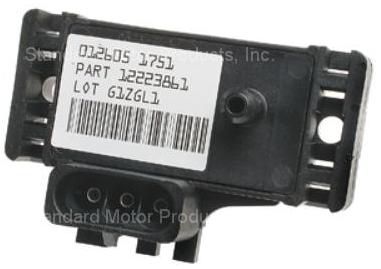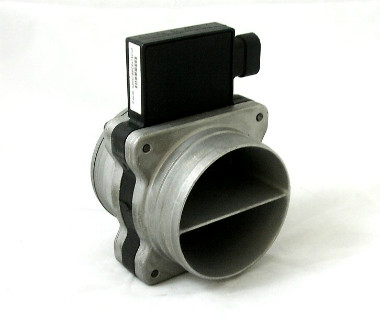MAP vs. MAF vs. IAT Sensors
What MAP Sensors Do

MAP is an acronym for "manifold absolute pressure." The MAP sensor is a key component in a speed density fuel injection system, and measures pressure and absence of pressure (vacuum) at the intake manifold.
MAP sensors typically have 3 wires: a 5 volt reference signal wire, a ground wire, and the wire that goes back to the engine control unit (ECU). The ECU, also known as the PCM and ECM, then calculates the air / fuel ratio based on volumetric efficiency (VE) tables within the computer, which is basically a magical grid in the computer that says "if you see this voltage from the MAP, then do this...".
MAP sensors are simple and can be easily used for higher performance applications, and we cover this topic here. The bad thing about these sensors is that they are part of the speed density fuel injection system. MAP sensors measure air pressure, but this system is designed to estimate the amount of air volume going into the engine based on this data without knowing exact amounts.
What IAT Sensors Do

IAT is an acronym for "intake air temperature." The IAT sensor measures the air temperature that is going into your intake manifold. The colder the air, the more dense it is, and the more fuel you need to keep your engine working smoothly.
Almost all IATs are simple two wire devices that measure resistance. As the air temperature changes, the resistance in the sensor changes and the ECU knows to change the air/fuel ratio based on this. Combine this data with that of the MAP sensor, and your computer can now give a pretty accurate guess of the volume of air moving through your engine. This is great news, but it's all based on calculations instead of solid numbers. This is where speed density is tossed aside and MAF sensors come in.

What MAF Sensors Do

MAF is an acronym for "mass air flow." Unlike IAT sensors, MAF sensors measure air volume with temperature at once. Remember, the MAP sensor above measured intake manifold pressure / vacuum and then estimated air volume with computer software. An MAF actually measures real air volume so that the computer doesn't need to guess what it might be.
As you can imagine, MAF's are typically more accurate ways of measuring the amount of air that goes into your engine. This sounds great, right? It is on a stock vehicle, and even lightly modified ones, but if you decide that you want to make way more horsepower than your car was ever intended for, then MAF just isn't going to cut it. Mass air flow sensors quickly become bottlenecks in your air intake system because they can only measure "X" air at once. If your engine needs more than "X" amount of air, then your MAF freaks out, causing your engine to run lean and quickly turns rotating engine parts into liquid hot magma. This is where speed density is welcomed back into the party, and brings along a couple of lovely friends, known as MAP and IAT.
So, as you can see, there are pros and cons to each, and the type of sensor installed depends on the vehicle and its modifications. Luckily, choosing one or the other only needs to happen when you modify your car to the extreme. If you have a stock car, your vehicle will have the best option depending on its design.

